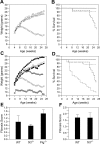The effects of intrinsic pathway protease deficiencies on plasminogen-deficient mice
- PMID: 15985536
- PMCID: PMC1895339
- DOI: 10.1182/blood-2005-02-0577
The effects of intrinsic pathway protease deficiencies on plasminogen-deficient mice
Abstract
Plasminogen (Plg)-deficient mice experience wasting and have decreased longevity due to disseminated fibrin deposition. We generated mice with combined deficiencies of Plg and coagulation factor IX (fIX) or XI (fXI) to determine the effects on the Plg null phenotype. Mice lacking Plg and fIX (Plg(-/-)/fIX-/-) have lower mortality at age 6 months than Plg(-/-)/fIX+/+ mice (15% and 67%, respectively) and less severe wasting, consistent with the importance of fIX in fibrin formation. In contrast, combined Plg and fXI deficiency (Plg(-/-)/fXI-/-) reduces life span (more than 90% mortality at 6 months) and is associated with leukocyte infiltration of the lungs and pulmonary fibrosis. These abnormalities are not seen in Plg-/- or Plg(-/-)/fIX-/- animals. Activated fXI is thought to function primarily as a fIX activator; however, our observation suggests that fXI may have functions in regulation of inflammation or tissue repair distinct from its role in coagulation.
Figures


Similar articles
-
Factor XI promotes hemostasis in factor IX-deficient mice.J Thromb Haemost. 2018 Oct;16(10):2044-2049. doi: 10.1111/jth.14243. Epub 2018 Aug 16. J Thromb Haemost. 2018. PMID: 30007049 Free PMC article.
-
Plasma Kallikrein Contributes to Coagulation in the Absence of Factor XI by Activating Factor IX.Arterioscler Thromb Vasc Biol. 2020 Jan;40(1):103-111. doi: 10.1161/ATVBAHA.119.313503. Epub 2019 Nov 26. Arterioscler Thromb Vasc Biol. 2020. PMID: 31766871
-
Associations of coagulation factors IX and XI levels with incident coronary heart disease and ischemic stroke: the REGARDS study.J Thromb Haemost. 2017 Jun;15(6):1086-1094. doi: 10.1111/jth.13698. Epub 2017 May 9. J Thromb Haemost. 2017. PMID: 28393470 Free PMC article.
-
Gene targeting in hemostasis. factor XI.Front Biosci. 2001 Feb 1;6:D201-7. doi: 10.2741/gailani. Front Biosci. 2001. PMID: 11171549 Review.
-
An update on factor XI structure and function.Thromb Res. 2018 Jan;161:94-105. doi: 10.1016/j.thromres.2017.10.008. Epub 2017 Oct 10. Thromb Res. 2018. PMID: 29223926 Free PMC article. Review.
Cited by
-
Factor XI and pulmonary infections.Haemophilia. 2018 Jul;24(4):519-521. doi: 10.1111/hae.13503. Epub 2018 May 29. Haemophilia. 2018. PMID: 29808936 Free PMC article. No abstract available.
-
Does plasmin have anticoagulant activity?Vasc Health Risk Manag. 2010 Apr 15;6:199-205. doi: 10.2147/vhrm.s9358. Vasc Health Risk Manag. 2010. PMID: 20407627 Free PMC article.
-
Absence of functional compensation between coagulation factor VIII and plasminogen in double-knockout mice.Blood Adv. 2018 Nov 27;2(22):3126-3136. doi: 10.1182/bloodadvances.2018024851. Blood Adv. 2018. PMID: 30459211 Free PMC article.
-
A non-circulating pool of factor XI associated with glycosaminoglycans in mice.J Thromb Haemost. 2019 Sep;17(9):1449-1460. doi: 10.1111/jth.14494. Epub 2019 Jun 17. J Thromb Haemost. 2019. PMID: 31125187 Free PMC article.
-
Activated factor XI inhibits chemotaxis of polymorphonuclear leukocytes.J Leukoc Biol. 2011 Nov;90(5):923-7. doi: 10.1189/jlb.0411182. Epub 2011 Aug 1. J Leukoc Biol. 2011. PMID: 21807745 Free PMC article.
References
-
- Collen D, Lijnen H. Fibrinolysis and the control of hemostasis. In: Stamatoyannopoulos G, Nienhuis AW, Majerus PW, Varmus H, eds. The Molecular Basis of Blood Disease. Philadelphia, PA: WB Saunders; 1994: 725-752.
-
- Plow E, Hoover-Plow J. The functions of plasminogen in cardiovascular disease. Trends Cardiovasc Med. 2004;14: 180-186. - PubMed
-
- Bugge TH, Flick MJ, Daugherty CC, Degen JL. Plasminogen deficiency causes severe thrombosis but is compatible with development and reproduction. Genes Dev. 1995;9: 794-807. - PubMed
-
- Ploplis V, Carmeliet P, Vazirzadeh S, et al. Effects of disruption of the plasminogen gene on thrombosis, growth, and health in mice. Circulation. 1995;92: 2585-2593. - PubMed
-
- Bugge TH, Kombrinck KW, Flick MJ, Daugherty CC, Danton MS, Degen JL. Loss of fibrinogen rescues mice from the pleiotropic effects of plasminogen deficiency. Cell. 1996;87: 709-719. - PubMed
Publication types
MeSH terms
Substances
Grants and funding
LinkOut - more resources
Full Text Sources
Molecular Biology Databases
Miscellaneous

